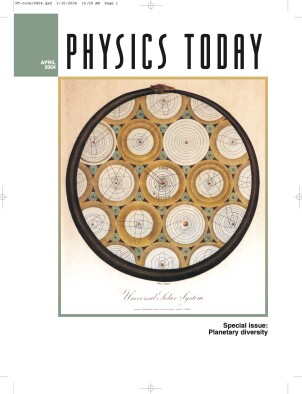New Silicon-Based Device Modulates Light at 1 GHz
DOI: 10.1063/1.1752413
At first glance, silicon makes lousy photonic devices. Although it transmits microwaves, it doesn’t lase efficiently, nor do its optical properties change readily in response to an electric field. But Si has one big advantage. Thanks to the electronics industry’s 50-year investment in the material, devices made from Si are cheap, powerful, and versatile. If Si-based devices could manipulate photons, computers could tap directly into the optical lines that carry gigabytes of data per second. You could download a full, high-definition movie to your PC in seconds.
To achieve that vision, researchers first need to develop a suite of Si-based components, such as light sources, waveguides, modulators, and detectors. Of those, two are especially difficult to make: a semiconductor laser for generating light and a fast modulator for converting electrical signals into optical signals. Both goals remain, but the second now looks closer.
A team from Intel Corp has made significant progress toward creating a practical Si-based electro-optical modulator. 1 Based on the trusty metal-oxide semiconductor transistor, Intel’s prototype can flip optical ones and zeros at a rate of 1 gigabit per second. That’s slow by today’s communication standards. Modern optical switches work at 10 GHz. But according to Intel’s Mario Paniccia, his group’s transistor-like device has ample room for optimization. Already, his simulations suggest 10 GHz is within reach.
The trick to getting Si to modulate light relies on the free-carrier dispersion effect. Like the free electrons in the ionosphere, charge carriers in Si have an intrinsic refractive index. Injecting or removing them changes the overall refractive index n. That route to a silicon-based modulator was first proposed in the 1980s by Richard Soref of Hanscom Air Force Base. Since Soref’s pioneering work, the challenge has been to vary carrier density with enough efficiency and speed to be useful.
The figure below shows a schematic cross section through the Intel device. Infrared light propagates in the z direction through a channel filled with p-doped polycrystalline Si (p-poly-Si) atop n-doped Si. Between the two types of Si lies a 12-nm layer of SiO2. When a driving voltage V D is applied to the aluminum contacts, holes gather on one side of the oxide layer, electrons on the other. This migration of charge, equivalent to running a capacitor in accumulation mode, causes a rapid change in n above and below the oxide layer.
Changing n induces a phase shift in light that passes through the channel. To make an electro-optical modulator, the Intel group yoked two of their phase-shifting devices together to form a Mach-Zehnder interferometer. In an MZI, a beam of light is split in two, sent through two phase shifters, then recombined. By manipulating the phase shifts, the recombined light can be made to interfere either constructively or destructively, depending on V D. The resulting output is a sequence of optical pulses whose peaks and troughs are controlled by the driving voltages.
The device is far from perfect. Losses within the p-poly-Si are high, but they could be reduced by making the channel out of single-crystal Si, a difficult but not insurmountable challenge in materials processing. To reach higher frequencies, the device, which is a few millimeters long, could be made smaller, essentially reducing the capacitance and resistance. “It’s a proof of principle, not a proof of technology,” comments Kumar Patel of UCLA’s department of physics and astronomy, “but it’s an exciting development.”

References
1. A. Liu et al., Nature 427, 615 (2004).https://doi.org/10.1038/nature02310
